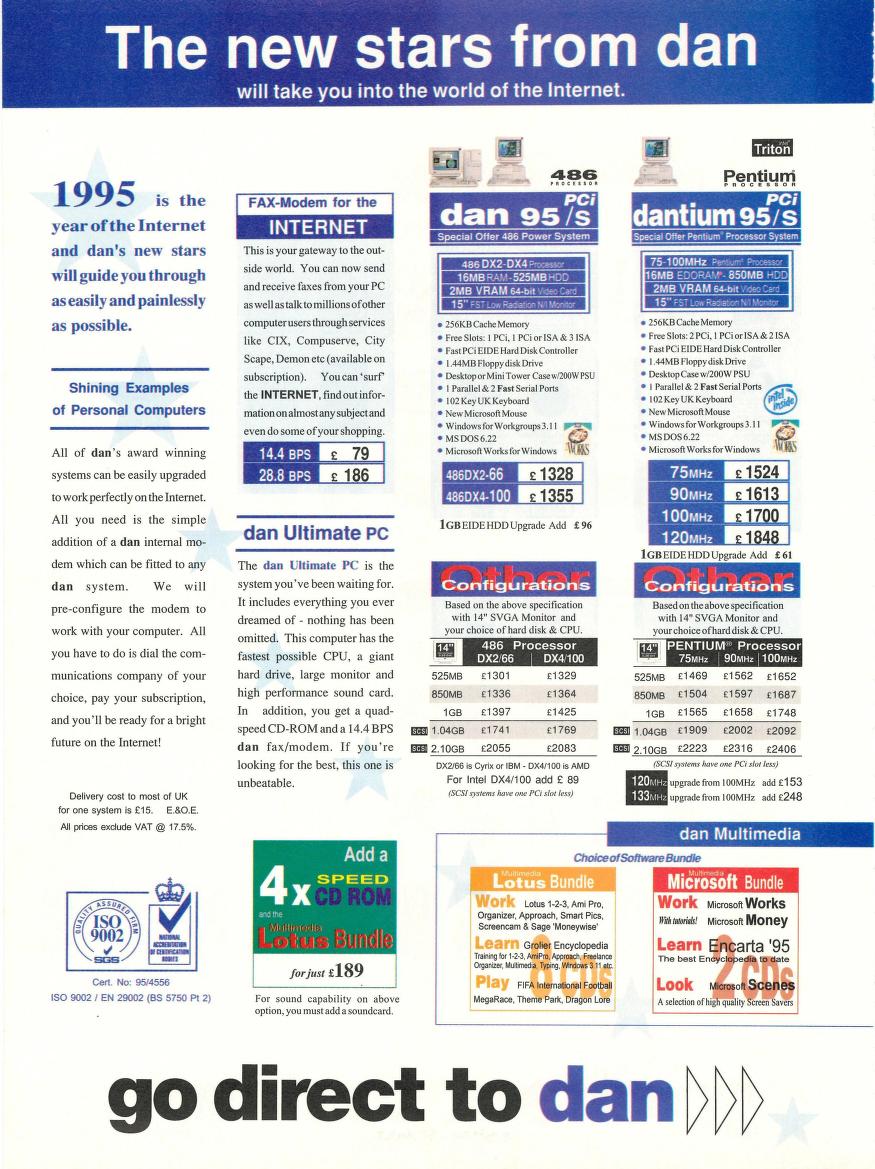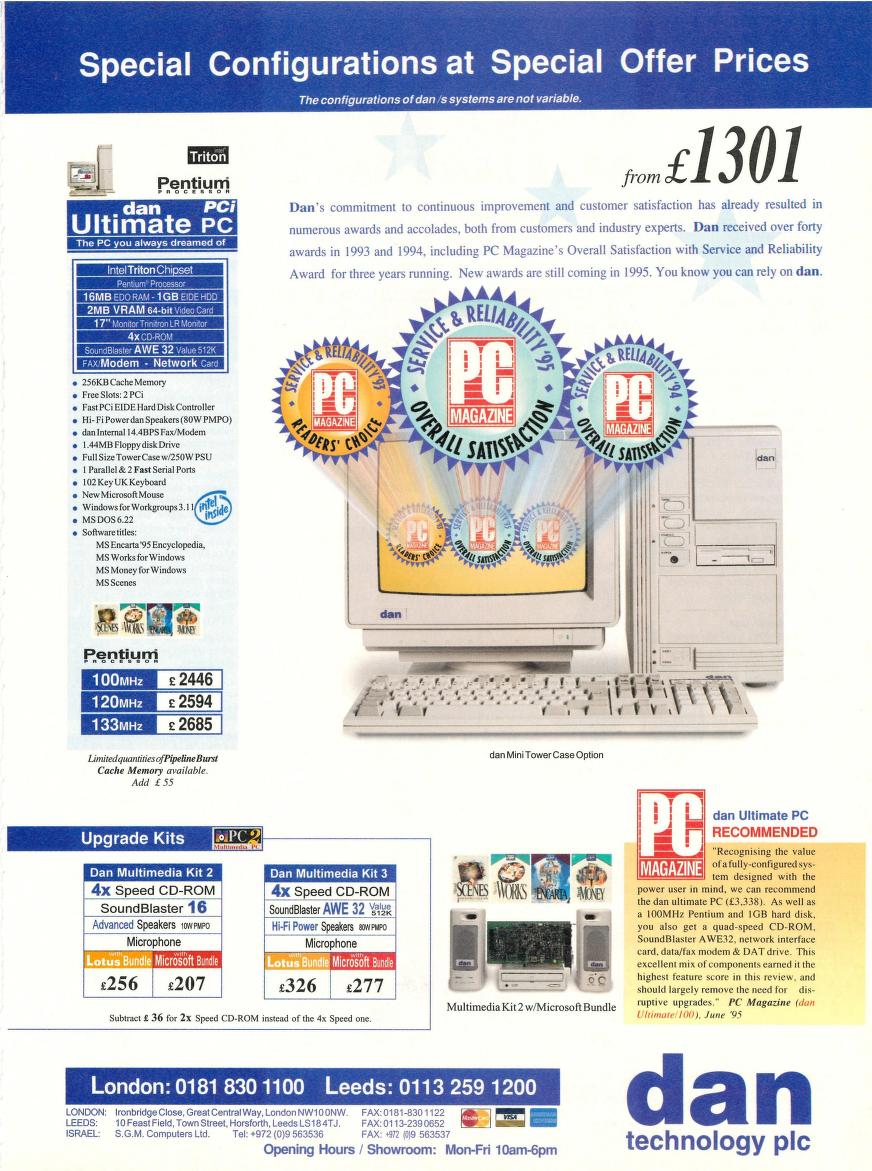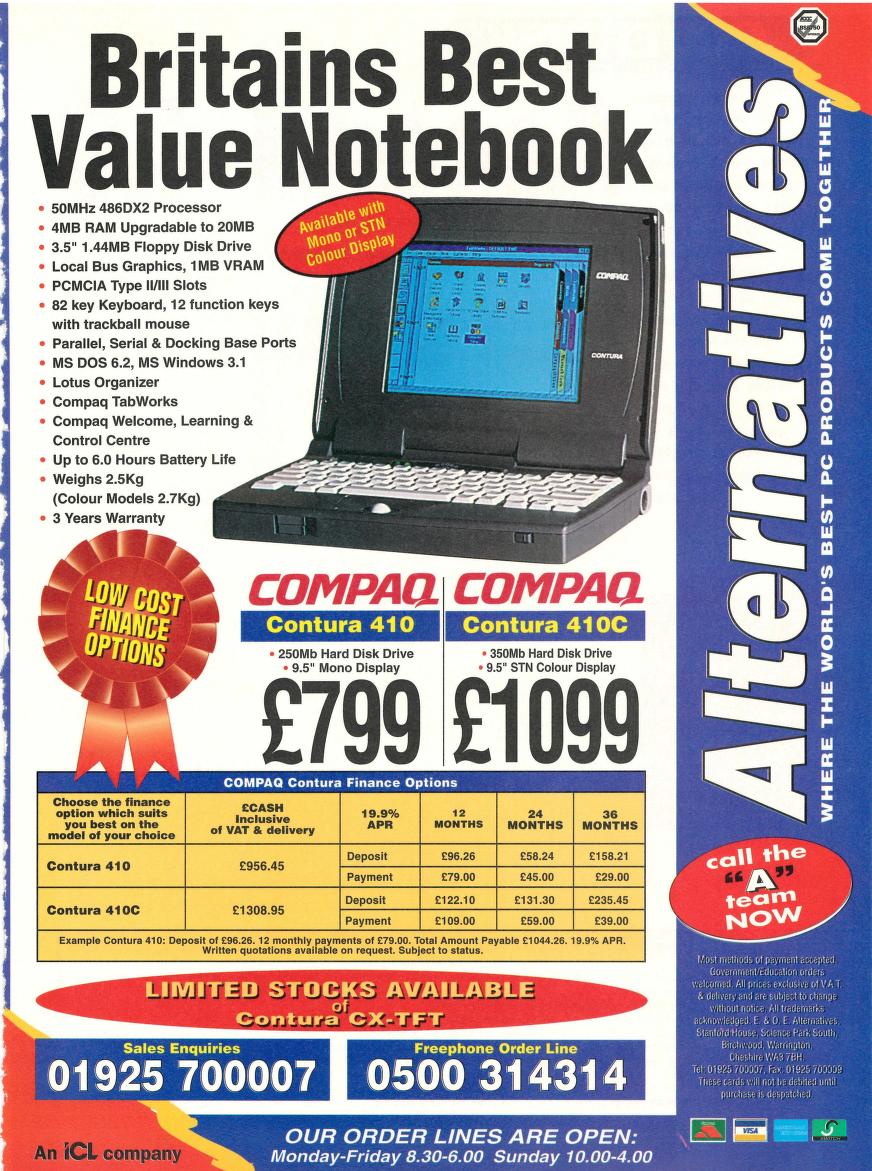 Typical PCs Each Year
Typical PCs Each Year
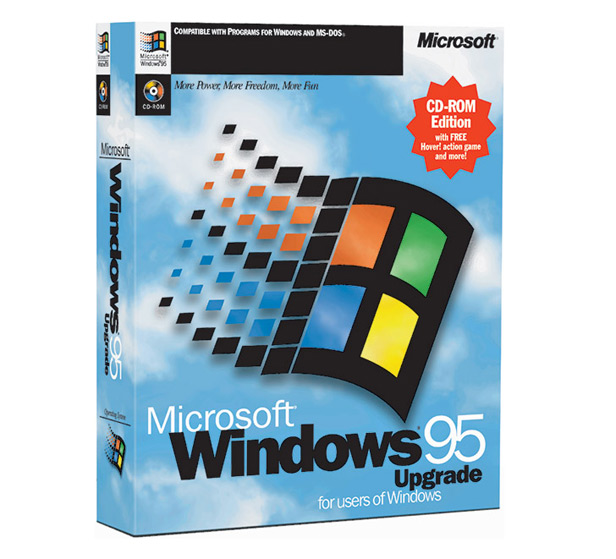 A New Windows!
A New Windows!
In late 1995, Microsoft launched Windows 95, which was supposed to be the end of DOS, although it had DOS 7.0 underneath which ensured Windows still had 100% DOS compatibility. By keeping MS-DOS in memory, Windows 95 could still use DOS device drivers. It provided a much fresher user interface over its predecessor, Windows 3.1, and it also introduced us to "plug & play".
Windows 95 has minimum system requirement of a 386DX with 4 MB of RAM and about 50 MB of hard disk space, though this would have been painfully slow. A more accurate minimum spec would be a 486SX-25 with 8 MB of RAM, and realistically the new OS ran well on a machine with a 33 MHz 486DX and 16 MB of RAM or better.
CPUS and Motherboards
Intel launched the Pentium 100 this year, giving about a 15% speed hike on the Pentium 90, but they had problems getting the 100 to run reliably. In most cases the cost of these Pentiums was still too high for the meager performance gains over the 90.
This year, Intel also launched the new ATX power specification, although we'd have AT for at least another year.
On motherboards, both ISA and PCI expansion slots tended to be present as a good mix (lots of ISA slots still), as well as coming with integrated floppy and IDE connectors. The common memory type was still the 72-pin SIMM, with sizes from 1 MB up to 32 MB - price per megabyte was around £30 in the UK. VESA Local Bus (VLB) was almost dead at this point, with PCI graphics cards now faster than VLB could ever be.
Peripherals
Monitors were the same as last year, but prices were falling. Typical screen sizes ranged from 14" up to 21" diagonal.
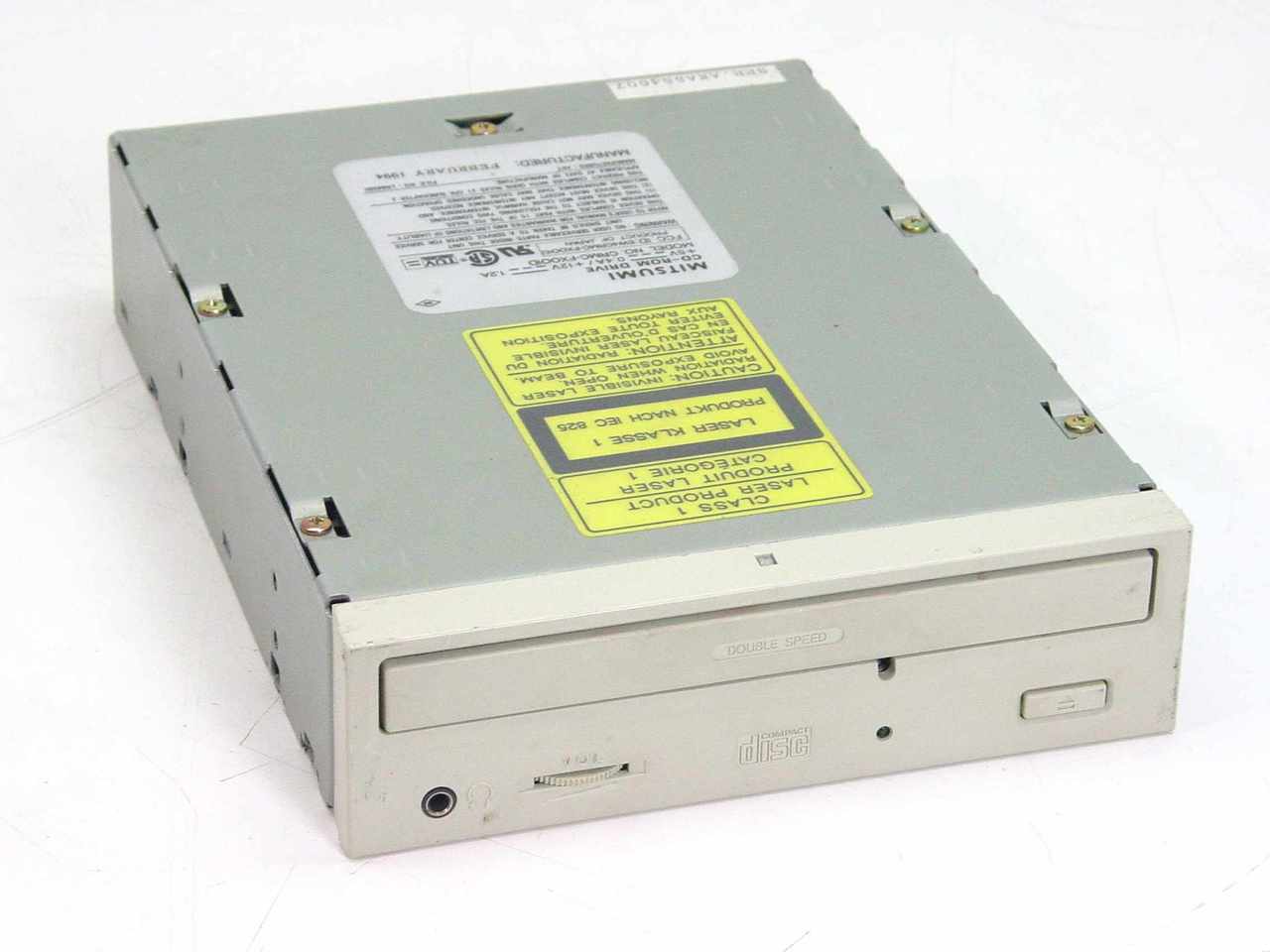 Almost all PCs now came with a CD-ROM drive, as this was now the standard medium for commercial software, as well as computer magazine freebies, a.k.a. the 'cover disk' was now the 'cover CD'. The old 5.25" floppy drive was now nowhere to be seen on new build PCs, but the 3.5" 1.44 MB high-density floppy drive was still a standard fit on all PCs.
Almost all PCs now came with a CD-ROM drive, as this was now the standard medium for commercial software, as well as computer magazine freebies, a.k.a. the 'cover disk' was now the 'cover CD'. The old 5.25" floppy drive was now nowhere to be seen on new build PCs, but the 3.5" 1.44 MB high-density floppy drive was still a standard fit on all PCs.
Enter 3D Graphics
3D graphics acceleration was the buzzword this year. In 1995, the 3D graphics market was gathering momentum. S3 first entered this market with their ViRGE series. ViRGE stood for "Virtual Reality Graphics Engine", and was one of the first GPUs (Graphic Processing Units) to target consumers. Their early ViRGE cards were PCI and came with 4 MB of dedicated RAM and ran their core and memory at up to 66 MHz. These cards also directly supported bilinear and trilinear texture filtering, MIP mapping, alpha blending, video texture mapping, Z-buffering and other 3D texture mapping commands. Unfortunately, performance was poor and didn't find favour with the general public.
Meanwhile, ATI launched the Rage 3D - it had slow EDO RAM, only a 32-bit data bus (the ViRGE was 64-bit), maximum memory onboard was 2 MB, and the core ran at a sluggish 40 MHz.
Video acceleration was really taking shape, and with the combo of Windows 95, faster CPUs and more memory, video playback on your desktop was now a reality. The remit of the latest range of professional graphics cards was to allow smooth, full-screen video scaling and 30 frames-per-second playback. They used compressed video formats such as Cinepak, Indeo, and MPEG to cope with the high throughput required to achieve this, taking a 24-bit colour depth and reducing it down to 8-bit colour and then dithering the frame all in software. But in 1995 a new breed of video accelerator chips with hardware compression arrived. These handled both colour depth conversion/dithering and scaling in hardware, and required only 1 MB of video memory to display video at 1024 x 768 in 8-bit colour. Such accelerator chips included the ATI Mach64, Matrox MGA2064W. I.C. Works ZoomDAC, S3 Vision 968, Western Digital WD9710, Videologic PowerPlay 64 and Tseng Labs VIPeR f/x.
Top-Selling Games
1995 brought us some amazing games, including Star Wars: Dark Forces, Transport Tycoon and System Shock.
UK DESKTOP PC Prices
In the UK you could still get the most basic XT computer if you were on a very limited budget and were just entering the PC market for the first time. A typical clearance PC was a 486SX-based machine with SVGA colour monitor. If your budget stretched a little higher the 486DX2-66 was the CPU to buy - twice the performance for about £200 or £300 more. You may not have got a sound card in the machine for this price. For the big spenders, a top-flight PC came with a Pentium (P55) running at 120 MHz, 16 MB of RAM, a CD-ROM drive and AWE32 sound card.
Cheapest/Clearance PCs
| Victor | Vicki XT | 640 KB RAM, 20 MB HDD, 3.5" 720K floppy, keyboard, 12" mono monitor. With Shinwa dot matrix printer (NLQ) and Lotus Works software suite. £199 exc. VAT. |
|---|---|---|
| Leading Edge | 386SX-16 | 1 MB RAM, 80 MB HDD, 14" mono VGA, US keyboard, MS-DOS 5.0. £250 exc. VAT |
| DTK | 486SX-40 | 4 MB RAM, 170 MB HDD, UMC "Green" 40 MHz CPU, VLB motherboard, 512K SVGA card, 14" VGA colour monitor, enhanced 102-key keyboard, MS-DOS 6. £499 exc. VAT. Upgrade to Windows 3.1 with mouse and ClarisWorks for £50 more. |
| IBM | PS/1 486SX-33 | 2 MB RAM, 80 MB HDD, 3.5" 1.44MB floppy, PS/1 colour VGA monitor, 102-key UK keyboard, mouse and MS-DOS 6. £499 exc. VAT. For £100 more, upgrade to a 486DX/33 with 4MB and 130MB HDD. |
Standard Budget PCs
| IBM | Blue Lightning 486DX2-66 | 4 MB RAM, 420 MB HDD, 32-bit VLB motherboard with 2 VESA slots, 1 MB video RAM, 14" low-rad SVGA colour monitor (.28 dot pitch), parallel and two serial ports, 102-key keyboard, mouse, DOS 6, Windows 3.1 and Microsoft Word/Excel/Access. Pentium-upgradable. £699 exc. VAT |
|---|---|---|
| Tandon | PAC II 486DX2-66 | 4 MB RAM, 420 MB HDD, 14" low rad SVGA colour monitor (.28 dot pitch), DOS 6, Windows 3.1, MS-Word 2, Excel v4 and Access v1, Mouse, Keyboard. £799 exc. VAT. |
| DTK | 486DX2-66 Multimedia | 4 MB RAM, 420 MB HDD, 128 cache RAM, VESA Local bus motherboard, dual-speed internal CD-ROM, 16-bit sound card and quality stereo speakers. 1 MB SVGA video and 14" .28 dot pitch colour SVGA monitor, 102-key keyboard, mouse, DOS 6, Windows 3.1, MS Works 3 CD and MS Encarta 95 CD. £899 exc. VAT. |
Premium PCs
| Trust | Quad Multimedia PC | DX4/100, 4 MB RAM, 560 MB HDD, SVGA card, 14" SVGA 0.28" dot pitch colour monitor, 4xCD-ROM drive, Sound Blaster Pro sound card, Microsoft s/w worth over £500. £999 exc. VAT (£1,174.99 inc. VAT). For 8 MB version, it's £1300 (inc. VAT) and for 16 MB version it's £1480 (inc. VAT). |
|---|---|---|
| Trust | Quad Multimedia PC | Pentium P90, 8 MB RAM, 560 MB HDD, SVGA card, 14" SVGA 0.28" dot pitch colour monitor, 4xCD-ROM drive, Sound Blaster Pro sound card, Microsoft s/w worth over £500. £1,362 exc. VAT (£1,600 inc. VAT). For 16 MB version it's £1750 inc. VAT. |
| Olivetti | M4-82 Modulo | Pentium 60 MHz, 8 MB RAM, 210 MB HDD, ISA SVGA card, 14" SVGA display. £1,879 exc. VAT. |
| Gateway 2000 | Elite | Pentium 120 MHz, Ensoniq sound card, ATI GX Mach graphics card, 4xCD-ROM drive (holds 3 CDs at same time), £2,400 inc. VAT |
| Dan Technology | Ultimate PC | Pentium 120 MHz, 16 MB EDO RAM, Intel Triton chipset, 1 GB EIDE hard disk, 2 MB VRAM video card, 17" Trinitron LR monitor, 4xCD-ROM, Sound Blaster AWE32 Value 512 KB, Fax/modem, Network card. Includes DOS, WFWG3.11, MS Works, MS Money. £2,594 exc. VAT. For Pipeline Burst Cache memory, add £55. |
| Viglen | Pentium 120 MHz, EDO RAM, 256KB cache, Mode 4 EIDE hard drive, £2,853 inc. VAT |
UK NOTEBOOK Prices
Cheapest/Clearance PCs
| Chicony | 386SL-25 | 2 MB RAM, 80 MB HDD, hi-res colour VGA LCD display, main or NiCad battery, luxury case, MS-DOS 6 and Windows 3.1. £699 exc. VAT. Upgrade to 4 MB RAM for £99. |
|---|
Standard Budget PCs
| Ambra | 486SX-25 | Sub-notebook. 4 MB RAM, 170 MB HDD, external 3.5" floppy, hi-res VGA LCD display, PCMCIA II slot, integral trackball, parallel and RS232 ports, DOS 6.2 and Windows 3.1. Carry case. £699 exc. VAT |
|---|---|---|
| Zenith | Z-Lite 425L | 486SL CPU, 4 MB RAM, 170 MB HDD, mono VGA display, NiMH battery with 6-hour life, twin PCMCIA II slots, LitePoint detachable trackball, DOS 6.2 and Windows 3.1. £750 exc. VAT. Upgrade to 8 MB RAM for £218. Extra NiMH battery £92. DC Car adapter £74, external 3.5" floppy £49. |
| Chicony | 486DX-33 | 4 MB RAM, 120 MB HDD, 3.5" 1.44 MB floppy, gas plasma VGA display, external SVGA port (512K video), 2 x serial ports, 1 x parallel port. DOS 6.2 and Windows 3.1. £799 exc. VAT |
OTHER STUFF
| CPU | Intel 80486 DX2/66 chip | £120 |
|---|---|---|
| CPU | AMD Am486DX4/100 chip | £120 |
| CPU | Intel 80486 DX4/100 chip | £195 |
| CPU | Intel Pentium Overdrive 63 MHz chip | £300 |
| Math Coprocessor | 8087 5, 8 or 10 MHz | £15 |
| Math Coprocessor | 80287 8, 10, 12 or 16 MHz | £25 |
| Math Coprocessor | 80387SX 16 or 20 MHz | £35 |
| Math Coprocessor | 80387DX 20 or 25 MHz | £35 |
| CD-ROM Drive | Philips CM-205 single-speed, multisession with MS Works 3 CD. | £79 |
| CD-ROM Drive | Panasonic CR562B double-speed (connects directly to SoundBlaster card w/ built-in interface) | £73 |
| CD-ROM Drive | Mitsumi FX400 quad-speed IDE (600 KB/sec transfer, <250ms access time) | £121 |
| CD-ROM Drive | NEC CDR271 quad-speed IDE drive | £140 |
| CD-ROM (External) | Philips CDD462 single speed, multisession with interface card and all cables | £79 |
| Memory | 2 MB, 30-pin SIMMs | £60 |
| Memory | 4 MB, 30-pin SIMMs | £118 |
| Memory | 8 MB, 30-pin SIMMs | £228 |
| Memory | 4 MB, 72-pin SIMMs (32-bit, 70ns access time) | £118 |
| Memory | 8 MB, 72-pin SIMMs (32-bit, 70ns access time) | £240 |
| Memory | 16 MB, 72-pin SIMMs (32-bit, 70ns access time) | £395 |
| Motherboard | 486 VLB motherboard - no cpu | £90 |
| CPU Cooler | 486 CPU Heatsink and Fan | £10 |
| Printer | Panasonic 9-pin dot matrix mono printer | £120 |
| Printer | Panasonic 24-pin dot matrix colour printer | £150 |
| Printer | Panasonic KXP2135 Colour printer | £175 |
| Printer | Canon BJ-30 Portable Bubblejet printer | £200 |
| Printer | Canon BJC-4000 Colour Bubblejet printer | £305 |
| Hard Disk | Samsung 560 MB 1" hard drive, 13ms access time, 128K cache | £140 |
| Floppy Disk | 10 x TDK 3.5" DS/DD floppy disks | £8 |
| Floppy Disk | 50 x TDK 3.5" DS/DD floppy disks | £23 |
| Floppy Disk | 10 x TDK MF-2HD disks | £10 |
| Floppy Disk | 50 x TDK MF-2HD disks | £28 |
| Sound Card | Creative Labs Sound Blaster 16 Value w/ Panasonic CD-ROM interface | £80 |
| Sound Card | Creative Labs Sound Blaster 16 Pro ASP IDE | £90 |
| Joystick | CH Flight Stick | £27 |
| Joystick | CH Flight Stick Pro | £48 |
| Joystick | Gravis Analogue | £24 |
